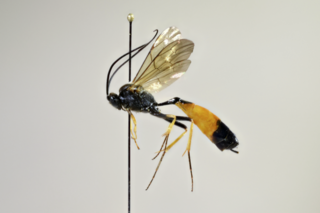
The Ichneumonidae, also known as ichneumon wasps, ichneumonid wasps, ichneumonids, or Darwin wasps, are a family of parasitoid wasps of the insect order Hymenoptera. They are one of the most diverse groups within the Hymenoptera with roughly 25,000 species described as of 2016. However, this likely represents less than a quarter of their true richness as reliable estimates are lacking, along with much of the most basic knowledge about their ecology, distribution, and evolution. It is estimated that there are more species in this family than there are species of birds and mammals combined. Ichneumonid wasps, with very few exceptions, attack the immature stages of holometabolous insects and spiders, eventually killing their hosts. They play an important role as regulators of insect populations, both in natural and semi-natural systems, making them promising agents for biological control.

The Braconidae are a family of parasitoid wasps. After the closely related Ichneumonidae, braconids make up the second-largest family in the order Hymenoptera, with about 17,000 recognized species and many thousands more undescribed. One analysis estimated a total between 30,000 and 50,000, and another provided a narrower estimate between 42,000 and 43,000 species.

Campopleginae is a large subfamily of the parasitoid wasp family Ichneumonidae with a world-wide distribution. Species in this subfamily have been used in the biological control of the alfalfa weevil, clover weevil, various species of Heliothis, oriental army worm, European corn borer, larch sawfly, and others.

Alsophila aescularia, the March moth, is a species of moth of the family Geometridae. It is found throughout Europe and can be a pest of fruit trees.

Xanthocryptus novozealandicus, the lemon tree borer parasite, is a wasp in the family Ichneumonidae. It is a native insect of New Zealand. It is also found in Australia and New Guinea. Females hunt for larvae of wood-boring beetles around March, including the lemon tree borer, a native cerambycid that tunnels into citrus trees, grapes and many native species. When a suitable host is found, the female pushes her ovipositor through the wood and injects her eggs into the grub. This has the incidental benefit of helping to control some pests. X. novozealandicus prefers to prey on second year lemon tree borer larvae. This specific parasite prefers to prey on larger second year larvae due to its larger size.
Diadegma melanium is a wasp first described by Carl Gustaf Thomson in 1887. It is a member of the genus Diadegma and family Ichneumonidae. It inhabits Sweden. No subspecies are listed. It is a parasitoid of Bucculatrix noltei.
Diadegma aegyptiacum is a wasp first described by Horstmann in 1993. No subspecies are listed. It is a parasitoid of Cryptoblabes gnidiella caterpillars.

Polistes nimpha is a eusocial paper wasp found all over Europe, with particular sightings in Turkey, Finland, Estonia, and Latvia. It is also found in northern Africa, Pakistan, Iran, India, Kazakhstan, Mongolia, and China. The climate in these areas is relatively cold and snowy in the winter, while summers are usually hot and dry, with steppe vegetation. Polistes nimpha colonies are relatively small and easily manipulated.

Anomalon is a large genus of parasitoid wasps belonging to the family Ichneumonidae. This may be the only genus in the tribe Anomalonini, although Neogreeneia Viereck, 1912 is sometimes considered a valid genus of the tribe.

Anomalon cruentatum is a species of parasitoid wasps belonging to the family Ichneumonidae.
Campoletis is a genus of parasitoid wasps belonging to the family Ichneumonidae.

Dusona is a genus of parasitoid wasps belonging to the family Ichneumonidae. It is the most species rich genus of the subfamily Campopleginae with 442 known species.

Dusona falcator is a large species of parasitic wasp belonging to the family Ichneumonidae, subfamily Campopleginae. It is a parasitoid of the buff-tip moth. It is one of the largest known species of Camopleginae, able to reach sizes over 20mm. The species can be found throughout the Palearctic realm.
Dusona admontina is a species of parasitic wasp belonging to the family Ichneumonidae, subfamily Campopleginae. It is a parasitoid of the larvae of Herminia grisealis.
Dusona abdominator is a species of parasitic wasp belonging to the family Ichneumonidae, subfamily Campopleginae.
Dusona aemula is a species of parasitic wasp belonging to the family Ichneumonidae, subfamily Campopleginae. It is a parasitoid of Geometrid moth larvae, mainly Eupithecia species.
Dusona juvenilis is a species of parasitic wasp belonging to the family Ichneumonidae, subfamily Campopleginae. It is a parasitoid of Eupithecia haworthiata larvae.
Dusona nidulator is a species of parasitic wasp belonging to the family Ichneumonidae, subfamily Campopleginae. It is a parasitoid, but the host is unknown.
Dusona terebrator is a species of parasitic wasp belonging to the family Ichneumonidae, subfamily Campopleginae. It is a parasitoid of Noctuid moth larvae.

Callidora is a genus of parasitoid wasps belonging to the family Ichneumonidae and the subfamily Campopleginae. It is relatively species poor, with only five recognized species.










